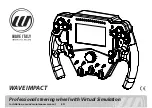
7-120
Operating Modes
MPH-02, MPB-02, MPD-02
DOK-INDRV*-MP*-02VRS**-FK01-EN-P
Parameter
P-0-0085, Dynamic angle offset
can be used for
compensating a lag error in operation with lag distance, if the mechanical
system does not allow lagless operation.
With dynamic angle offset the profile access angle is offset depending on
the velocity so that the internal master axis position can be calculated
according to the formula below:
offset
angle
dyn
factor
Kv
V
vel
axis
master
ernal
position
axis
master
ernal
position
axis
master
ernal
effective
.
*
.
int
int
int
_
−
+
=
ϕ
ϕ
internal: after electronic gear (P-0-0156/P-0-0157) and fine adjust (P-0-0083)
Fig. 7-93:
Generating the dynamic angle offset
Note:
The master axis velocity used is generated on the timebase
T
A
= communication cycle time so that a moving average filter
results with T
A
= N * T
position
.
For the special case "clocked pull roll" it is possible, with bit 5 = 1 of
parameter
P-0-0088, Control word for synchronous operation modes
,
to change between
P-0-0093, Cam shaft distance
and
P-0-0073, Cam
shaft distance 2
, depending on the gradient of the cam shaft.
Positive gradient means that
P-0-0093, Cam shaft distance
is active,
negative gradient means that
P-0-0073, Cam shaft distance 2
is active.
By means of the command values of
P-0-0755, Gear reduction
a cross
cutter axis can be operated. A cross cutter (rotating knife) is used to cut a
defined piece (format) off some material that is transported at constant
velocity. The format is set by the electronic gear. With an electronic gear
1:1 the format corresponds to the circumference of the cutting cylinder
(with number of knives = 1). Smaller formats are realized by an electronic
gear [(output/input) > 1]. The slave axis (cutting cylinder) then turns faster
than the master axis. In this case, the cutting cylinder, in the cutting
range, has to be decelerated to the transport velocity of the material. After
the cutting range the cylinder is accelerated again. This is achieved by
superimposing a more or less sinusoidal cam shaft to the constant speed
of the axis that is caused by the linear component of the gear reduction.
With constant cam shaft profile it is then possible to define, by means of
the cam shaft distance, whether the axis decelerates (distance > 0) or
accelerates (distance < 0) within the cutting range.
•
The number of knives that are distributed at the circumference of the
cutting cylinder is entered in parameter
P-0-0755, Gear reduction
.
Per cam shaft profile sequence, the cutting cylinder will move by the
distance of two knives at the circumference.
•
To change the format "on the fly" it is necessary to simultaneously
change electronic gear and cam shaft distance in the cutting range.
This function is switched on by setting bit 4 in
P-0-0088, Control word
for synchronous operating modes
. A change in the electronic gear
will only take effect when the new value, after having changed the cam
shaft distance, is accepted when passing the angle of
P-0-0144, Cam
shaft distance switch angle
.
Dynamic Angle Offset
Clocked Pull Roll
Cross Cutter Function
Courtesy
of
CMA/Flodyne/Hydradyne
▪
Motion
Control
▪
Hydraulic
▪
Pneumatic
▪
Electrical
▪
Mechanical
▪
(800)
426-5480
▪
www.cmafh.com
















































